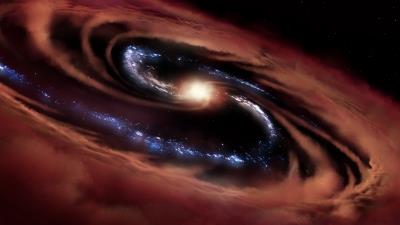
[ad_1]
(MENAFN – IANS)
Washington, November 28 (IANS) Researchers have discovered a galaxy that managed to survive starvation of a black hole by continuing to give birth to new stars, about 100 stars the size of the Sun per year.
The discovery of NASA’s telescope on a plane, the Stratospheric Observatory for Infrared Astronomy (SOFIA), may help explain how massive galaxies originated, even though the universe today is dominated by galaxies that no longer form stars, according to the study. published in the Astrophysical Journal.
“This shows us that the growth of active black holes does not stop the birth of stars instantly, which goes against all current scientific predictions,” said study co-author Allison Kirkpatrick, Assistant Professor at the University of Kansas at Lawrence. Kansas, USA.
“It’s making us rethink our theories of how galaxies evolve.”
SOFIA, a joint project of NASA and the German Aerospace Center, DLR, has studied an extremely distant galaxy, located more than 5.25 billion light-years away called CQ4479.
At its core is a special type of quasar that was recently discovered by Kirkpatrick called a “cold quasar”.
In this type of quasar, the active black hole is still feasting on material from the host galaxy, but the intense energy of the quasar has not devastated all the cold gas, so stars can continue to form and the galaxy survives.
This is the first time that researchers have examined a cold quasar in detail, directly measuring the growth of the black hole, the birth rate of the stars, and how much cold gas remains to power the galaxy.
“We were surprised to see another whimsical galaxy that challenges current theories,” said Kevin Cooke, a postdoctoral researcher at the University of Kansas in Lawrence, Kansas, and lead author of this study.
“If this tandem growth continues, both the black hole and the stars surrounding it would triple in mass before the galaxy reaches the end of its life.”
As one of the brightest and most distant objects in the universe, quasars or “near-stellar radio sources” are notoriously difficult to observe because they often eclipse everything around them.
They form when a particularly active black hole consumes huge amounts of material from the surrounding galaxy, creating strong gravitational forces.
-IANI
gb / a
MENAFN28112020000231011071ID1101199843
Legal Disclaimer: MENAFN provides the information “as is” without warranties of any kind. We accept no responsibility for the accuracy, content, images, videos, licenses, completeness, legality or reliability of the information contained in this article. If you have any complaints or copyright issues related to this article, kindly contact the supplier above.
.
[ad_2]
Source link